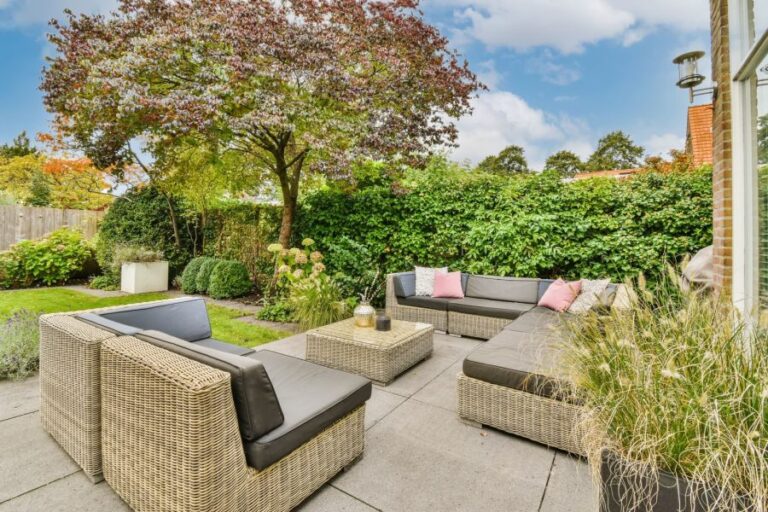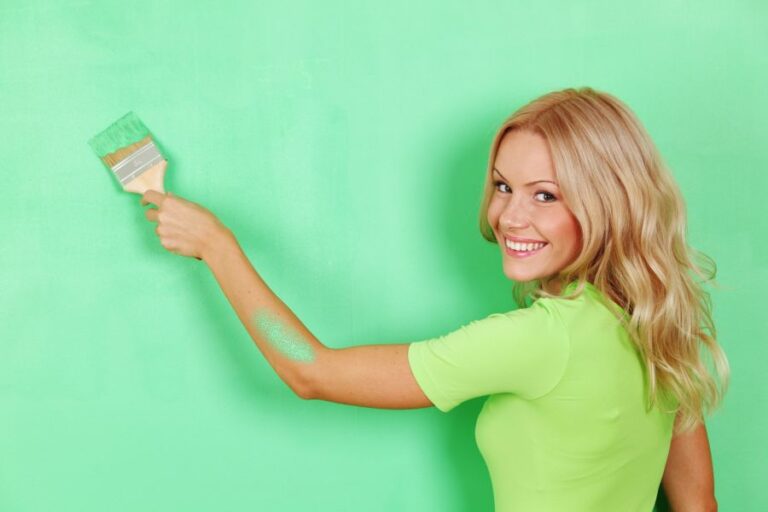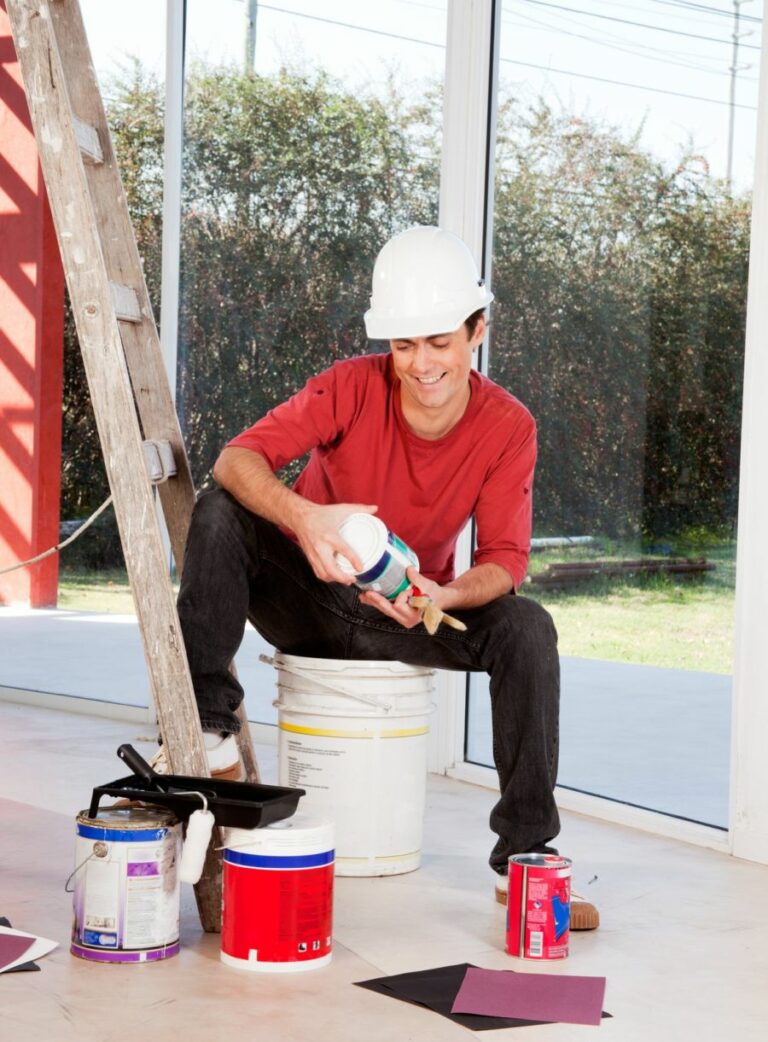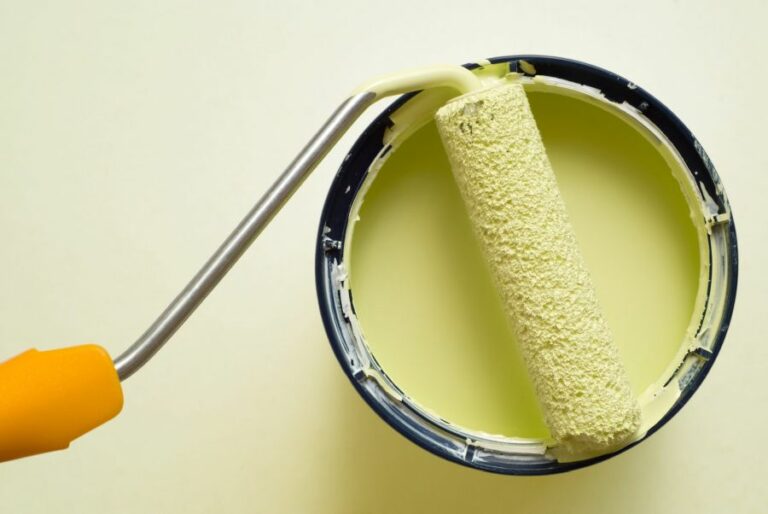What Kind Of Paint To Use On Outdoor Furniture, What Pros Say
Tired of your outdoor furniture looking dull and worn? Breathe new life into your favorite pieces by giving them a fresh coat of paint! But with so many options available, choosing the right paint can feel like navigating a maze. Fret not! I will help you make informed decisions, showcasing the best paint types and brands for materials, weather conditions, and desired finishes.
What kind of paint to use on outdoor furniture:
Choosing the right paint for outdoor furniture enhances appearance and durability. Common paint types for outdoor furniture include latex, oil-based, and acrylics. Latex paint is versatile and resistant to fading, although it may not perform well in extreme weather conditions. Oil-based paint offers a smooth, glossy finish but has a longer drying time and is not environmentally friendly. Acrylic paint is a popular choice for various finishes but may not adhere to metal surfaces. Select a finish that suits your desired appearance, with matte and high-gloss options available. Proper surface preparation, including cleaning, sanding, and priming, is crucial for a long-lasting finish.

Discover the ideal type of paint to transform and protect your outdoor furniture, including popular options like acrylic, oil-based, spray paint, and more. Read on to learn about durability, finishes, and application techniques that ensure a long-lasting, vibrant result.
Contents
- 1 What Type of Paint Should Be Utilized for Outdoor Furniture?
- 2 What Type of Paint is Suitable for Outdoor Furniture?
- 3 What is the Optimal Type of Paint for Painting Outdoor Furniture?
- 4 Is Priming Necessary for Outdoor Furniture Prior to Painting?
- 5 What Type of Paint is Required for Exterior Wood Surfaces?
What Type of Paint Should Be Utilized for Outdoor Furniture?
Outdoor furniture plays a crucial role in enhancing our outdoor living spaces’ overall appearance and comfort. However, finding the perfect type of paint to use on these pieces can be daunting due to the wide variety of paint types and finishes available.
• Understanding the Different Types of Paint
There are several types of paint that can be used on outdoor furniture, each with its own unique benefits and disadvantages. The most common paint types are latex, oil-based, and acrylic.
To make the best decision for your specific project, it is essential to understand the unique characteristics of each paint type.
– Latex Paint
Latex paint is a water-based paint that is easy to apply, dries quickly, and has low levels of toxic fumes. It is highly versatile and can be used on a variety of surfaces, including wood, metal, and plastic furniture.
Latex paint is also highly resistant to fading, chipping, and peeling, making it an ideal option for outdoor furniture.
However, latex paint may not perform well in extreme weather conditions, such as extreme heat or cold, and may break down and crack over time.
– Oil-Based Paint
Oil-based paint is highly durable and provides a smooth, glossy finish that is resistant to moisture and wear. This type of paint is an excellent choice for outdoor furniture, as it can withstand harsh weather conditions and adhere well to various surfaces, including metal and wood.
However, oil-based paint takes longer to dry than latex paint and emits a strong odor that may require adequate ventilation during application. It is also not as environmentally friendly due to its high volatile organic compounds (VOCs) levels.
– Acrylic Paint
Acrylic paint is a versatile option that is well-suited for outdoor furniture projects. It is a water-based paint that is easy to apply, dries quickly, and provides a durable finish that can resist fading, chipping, and peeling.
Acrylic paints are also available in various finishes, including matte, semi-gloss, and high-gloss.
Although acrylic paint is a popular choice, it may not adhere as well to metal surfaces and may require a primer or additional surface preparation.
• Selecting the Ideal Paint Finish
The paint finish you select for your outdoor furniture will significantly affect your project’s overall appearance and durability. The most popular paint finishes are matte, satin, semi-gloss, and high-gloss.
– Matte Finish
A matte finish provides a flat, non-reflective appearance that is ideal for masking minor surface imperfections. While matte paints are less resistant to wear and tear compared to glossier finishes, they provide a modern and sophisticated look for outdoor furniture.
– Satin Finish
Satin finishes offer a slight sheen and are more durable than matte finishes. They are also easier to clean and maintain, making them a popular choice for outdoor furniture.
– Semi-Gloss Finish
A semi-gloss finish provides a subtle shine that is more resistant to wear and tear than satin finishes. Semi-gloss paints are easy to clean and maintain, making them suitable for high-traffic outdoor furniture areas.
– High-Gloss Finish
High-gloss finishes provide a shiny, reflective appearance that is highly resistant to wear and tear. They are easy to clean and maintain but may highlight surface imperfections and require additional surface preparation during application.
• Preparing Your Outdoor Furniture for Painting
Proper surface preparation is essential to ensure that your paint adheres well and provides a long-lasting finish. Before applying paint to your outdoor furniture, follow these crucial steps:
- Clean the furniture thoroughly: Remove any dirt, grime, mildew, or rust using water, soap, and a soft-bristled brush.
- Sand the surface: Lightly sand all surfaces to be painted using fine-grit sandpaper. This process will help remove any existing paint or finish and create a smooth surface for painting.
- Apply a primer: Apply a suitable primer (depending on the type of paint selected and furniture material) to ensure proper paint adhesion and to reduce the chances of peeling or chipping.
- Allow the primer to dry: Follow the instructions on the primer can or consult the manufacturer’s guide for drying time.
Proper preparation, paint selection, and finishing can transform and enhance your outdoor furniture’s appearance and durability.
Remember to consider the specific requirements of your project, including the existing furniture materials, weather conditions, and desired appearance, when selecting the ideal paint type and finish. Happy painting!
What Type of Paint is Suitable for Outdoor Furniture?
Painting outdoor furniture can give new life to worn, weathered pieces and add a fresh pop of color to your outdoor living space. With a wide variety of paint products on the market, it can be challenging to determine which type of paint is best suited for your specific needs.
The key to a successful, long-lasting paint job is choosing the right paint for the material of your furniture, as well as proper preparation and application techniques.
• Types of Paint for Outdoor Furniture
– Acrylic Paints
Acrylic paints are water-based and offer an easy-to-use and versatile option for painting outdoor furniture. They are known for their durability, quick drying time, and resistance to fading from sunlight. There is a wide variety of acrylic paint products available on the market, including:
Acrylic Latex Paint
This is perhaps one of the most popular choices for painting outdoor furniture. Acrylic latex paint offers excellent adhesion, making it suitable for various surfaces such as wood, metal, and plastic. It is also resistant to cracking and peeling.
Recommendation: For a great acrylic latex paint option, consider using Behr Premium Plus Exterior Paint due to its superior durability and weather resistance.
100% Acrylic Paint
100% acrylic paint is another excellent option for outdoor furniture. It is known for its superior adhesion and flexibility, making it an ideal choice for surfaces that may experience temperature fluctuations and moisture exposure.
Recommendation: Sherwin-Williams Duration Exterior Acrylic Latex Paint is a high-quality option that offers excellent coverage and longevity.
– Oil-Based Paints
Oil-based paints are another option for painting outdoor furniture. They offer a more durable and long-lasting finish compared to water-based paints but are slower to dry and may require more skill to apply correctly.
Alkyd Enamel
Alkyd enamel paint is an oil-based option that provides a strong and durable finish, making it suitable for outdoor furniture exposed to the elements. It is particularly suitable for metal surfaces, as it offers excellent rust prevention.
Recommendation: The Rust-Oleum Protective Enamel range is a reliable choice that offers a rust-preventative finish and is available in various colors.
– Specialty Paints
Specialty paints are designed specifically for certain materials and applications. They can offer improved performance and durability compared to more generic paint options.
Fabric Paint
If you’re looking to paint upholstered or fabric-based outdoor furniture, fabric paint is your best option. This specialty paint is designed to maintain the flexibility and breathability of the fabric while adding color and protection.
Recommendation: Spray Outdoor Waterproof Fabric Paint is designed specifically for outdoor use and offers a waterproof finish.
Plastic Paint
For painting plastic outdoor furniture, look for paints explicitly designed for use on plastics. These paints usually include additives for improved adhesion and resistance to cracking.
Recommendation: Krylon Fusion All-In-One Spray Paint is an excellent option for plastic surfaces, as it bonds quickly and provides a long-lasting finish.
• Preparing Outdoor Furniture for Painting
Proper preparation is essential for achieving the best results when painting outdoor furniture. Before beginning the painting process, follow these steps:
- Clean the furniture thoroughly, removing any dirt, grease, and mildew.
- For wood or metal furniture, sand the surface to remove any old paint or finish and create a smooth surface for the paint to adhere to.
- If necessary, apply a primer suited to the material you are painting. Primer helps improve paint adhesion and can offer additional protection elements like rust prevention.
- Allow the surface to dry completely before starting the painting process.
• Painting Techniques for Outdoor Furniture
When painting outdoor furniture, using the appropriate application technique is crucial for a smooth and even finish. Brush and roller techniques can be used for acrylic and oil-based paints, while spray paint is best applied with a spray gun or aerosol can.
- Ensure that you have adequate ventilation if you are using oil-based paints or spray paints, as the fumes can be hazardous.
- Apply multiple thin coats of paint rather than a single thick coat. This will help prevent drips and runs in the finish.
- Allow each coat to dry fully before applying the next coat.
- After the final coat has dried, consider applying a clear sealer to protect the paint job and extend its longevity.
In conclusion, the best type of paint for your outdoor furniture depends on the material it is made from and your desired finish. Acrylic paints, both latex and 100% acrylic, are popular for many surfaces due to their versatility and ease of use.
Oil-based alkyd enamel paints are great for durability, while specialty paints for fabric and plastic offer targeted solutions for specific materials. With proper preparation, application, and care, your newly painted outdoor furniture will maintain its fresh, revitalized appearance for years to come.
What is the Optimal Type of Paint for Painting Outdoor Furniture?
When it comes to painting outdoor furniture, not all paints are created equal. With a wide range of materials and types of outdoor furniture, it is essential to choose the right paint to ensure the longevity and durability of your project.
• Understanding the Different Types of Paint for Outdoor Furniture
Outdoor furniture can be made of various materials, including wood, metal, plastic, and wicker. Therefore, choosing the appropriate paint for each specific material is crucial.
– Latex Paint
Latex paint is a popular choice for painting outdoor furniture, especially when it comes to wooden items. It is water-based, making it easy to clean up and environmentally friendly.
Advantages:
- Dries quickly
- Easy to apply and clean up
- Available in a wide range of colors and finishes
- Resistant to UV rays and mildew
- Less odor compared to oil-based paints
Disadvantages:
- May not adhere well to some surfaces, requiring a primer
– Oil-based Paint
Oil-based paint is a durable outdoor furniture option, especially for metal surfaces.
Advantages:
- Extremely durable and long-lasting
- Better adhesion to various surfaces
- Smooth and glossy finish
Disadvantages:
- Takes longer to dry
- Strong odor and toxic fumes
- Requires mineral spirits for clean up
– Spray Paint
Spray paint is a convenient option for outdoor furniture, saving time and effort. It is available in various types, including latex, oil-based, and specialized paints for specific materials such as plastic or metal.
Advantages:
- Quick and easy application
- Even coverage without brush marks
- Excellent adhesion and durability
- Suitable for hard-to-reach areas
Disadvantages:
- Can be messy if not controlled properly
- Requires proper ventilation and protection during application
- Less eco-friendly than brush-on types
– Specialty Paints
Specialty paints are formulated explicitly for specific types of surfaces, such as metal, plastic, and wicker, offering optimal adhesion and durability.
Advantages:
- Excellent adhesion to specific materials
- Durable and long-lasting finishes
- Various options such as rust prevention for metals
Disadvantages:
- Limited color options
- May not be suitable for other surface types
• Choosing the Best Paint for Your Outdoor Furniture
After exploring the different types of paint options available, it’s essential to determine the best paint for your outdoor furniture project. Here are some recommendations based on my experience.
– Best Paint for Wood Furniture
We recommend using latex paint for wooden outdoor furniture due to its excellent UV resistance, mildew resistance, and easy cleanup. Before applying latex paint, be sure to sand and clean the surface for better adhesion properly. Consider using a primer for an even better bond.
– Best Paint for Metal Furniture
Oil-based paint or specialized metal paint is recommended for painting outdoor furniture. These paints provide excellent adhesion and durability, protecting the metal from rust and corrosion.
Before painting, clean the surface thoroughly and remove any rust present, then use a primer designed for metal surfaces.
– Best Paint for Plastic Furniture
For plastic outdoor furniture, specialty plastic paint or spray paint designed for plastic surfaces is the best choice. These paints have been formulated to adhere to the unique properties of plastic and provide long-lasting, durable finishes. Make sure to clean the surface well and use a plastic primer if necessary.
– Best Paint for Wicker Furniture
Wicker outdoor furniture can be painted using either latex or oil-based paints. However, to ensure even coverage and adhesion, we recommend using spray paint, as it can easily reach the crevices and corners of wicker weaves. Make sure to clean and prepare the surface thoroughly before painting.
• Final Thoughts
Investing time and effort into painting your outdoor furniture enhances its appearance and contributes to its longevity. Choosing the right paint for your specific type of furniture is crucial for a successful and long-lasting result.
Consider the advantages and disadvantages of the different paint types discussed in this article, and make an informed decision based on your outdoor furniture needs. With the proper preparation and application, your outdoor furniture will look refreshed and ready to withstand many seasons.
Type of Paint | Advantages |
|---|---|
Latex Paint | Easy to apply, durable, and fast-drying |
Oil-Based Paint | Provides long-lasting protection, weather resistance, and cover surface imperfections |
Acrylic Paint | Weather-resistant, fade-resistant, suitable for various surfaces |
Enamel Paint | Hard and glossy finish, long-lasting, and easy to clean |
Is Priming Necessary for Outdoor Furniture Prior to Painting?
Priming outdoor furniture before painting has several benefits, including providing a smoother, durable finish and preventing the wood from absorbing excess paint.
The following sections discuss the importance of priming, the various types of primers, and recommended techniques to optimize your painting experience.
• Importance of Priming Outdoor Furniture
Priming serves as the foundation for your paint job. Here are some key benefits to consider when painting your outdoor furniture:
– Enhanced Adhesion
Priming creates a surface that paint can easily bond to, ensuring the longevity of the finish. Without proper priming, paint can peel, flake, or chip away from the furniture, requiring frequent touch-ups or repainting.
– Improved Surface Appearance
Priming fills in small imperfections, dents, and scratches, resulting in a smoother, even surface for the paint. This helps avoid visible imperfections once the painting is complete.
– Enhanced Color Appearance
Primer prevents the wood’s natural color from showing through the paint. This is particularly essential when using light-colored paint, ensuring a uniform appearance after painting.
– Protection
Primers help protect the wood by sealing the surface, minimizing the risk of moisture damage and wood rot.
– Paint Efficiency
Priming prevents wood from absorbing paint, allowing efficient and even distribution of paint layers. This ultimately saves you time and money by reducing the amount of paint required.
• Types of Primers for Outdoor Furniture
Selecting the right primer for your outdoor furniture is crucial. Here are some common types of primers and their applications:
– Oil-Based Primer
Oil-based primers are suitable for outdoor wood furniture, providing excellent adhesion and durability. However, they take longer to dry and may have strong odors, so ensure proper ventilation during application.
– Water-Based Primer
Water-based primers are quick-drying, low-odor, and easy to clean up with water, making them popular. These primers are suitable for most surfaces, including wood, metal, and plastic.
– Shellac Primer
Shellac primers have a reputation for their exceptional adhesion and stain-blocking properties. They also offer excellent sealing, preventing wood tannins from bleeding through the paint. However, they are less resistant to water, so they may not be suitable for all outdoor furniture types.
– Rust-Inhibiting Primer
If your furniture is metal and prone to rust, it is essential to use a rust-inhibiting primer that provides protection against rust.
• Preparing the Surface for Priming
Before applying primer, take time to prepare the outdoor furniture for optimal results:
- Clean: Remove any dirt, dust, or debris from the surface. Use a brush or vacuum to clean crevices and tight corners.
- Sand: Sanding helps create a smooth surface and increases primer adhesion. Start with medium-grain sandpaper (80 to 100 grit) and move to fine-grain (150 to 180 grit). For metal furniture, use finer grit to avoid scratches.
- Remove Old Paint and Rust: If repainting, remove any old, loose paint or rust flakes using a scraper or wire brush.
- Fill Imperfections: Use wood filler or putty to fill in any deep scratches, dents, or holes. Once dry, sand the area smoothly before priming.
- Wipe Down: Wipe down the surface with a damp or tack cloth to remove sanding dust.
• Priming Techniques
- When applying primer, use a brush, roller, or sprayer, depending on the outdoor furniture’s size and complexity.
- Apply a thin and even coat of primer, covering the entire surface.
- Allow the primer to dry according to the manufacturer’s instructions. Oil-based primers may take up to 24 hours to dry, while water-based primers dry in approximately 1-2 hours.
- Once dry, lightly sand the primed surface with fine-grit sandpaper to ensure a smooth finish. Be careful not to sand through the primer, exposing the bare wood.
- Wipe down the surface again to remove sanding dust before applying the paint.
• Final Thoughts
Priming outdoor furniture before painting is crucial to ensure a long-lasting, smooth, and even finish. However, the success of your paint job lies in correct surface preparation and choosing the most suitable primer for your specific furniture type.
By following the recommended techniques, you will enhance the appearance and longevity of your outdoor furniture, allowing you to enjoy it for many years to come.
What Type of Paint is Required for Exterior Wood Surfaces?
Outdoor wood surfaces require protection from the elements, and choosing the right paint is essential in ensuring their longevity. The type of paint chosen will vary depending on factors such as exposure to sunlight, moisture, and the purpose of the wood surface.
• Main Types of Paint for Outdoor Wood
– Oil-Based Paint
One of the most effective choices for painting outdoor wood is oil-based paint. Oil-based paint contains a solvent that evaporates during drying, leaving behind a durable and flexible film.
This type of paint is generally considered to be more protective, expanding and contracting with the wood, allowing it to withstand the elements better. Oil-based paint is likely your best choice for surfaces subjected to strong sunlight or fluctuating temperatures.
Pros:
- Highly durable and long-lasting
- Excellent adhesion to wood surfaces
- Resistant to cracking and peeling
Cons:
- Longer drying time compared to water-based paints
- Strong odor and requires mineral spirits for clean-up
- Potential environmental concerns due to high levels of volatile organic compounds (VOCs)
– Acrylic Latex Paint
Acrylic latex paint is another suitable option for painting outdoor wood. This water-based paint is made from a blend of acrylic polymers and latex, creating a durable and flexible film on the wood surface.
Acrylic latex paint is ideal for surfaces exposed to moisture, given its ability to breathe, allowing the passage of water vapor without trapping moisture behind the paint film.
Pros:
- Quick-drying and easy clean-up with water
- Low VOC content compared to oil-based paint
- Available in a wide range of colors and finishes
Cons:
- Less resistant to expansion and contraction of wood in fluctuating temperatures
- May require multiple coats for even coverage
– Alkyd Paint
Alkyd paint is another oil-based option for outdoor wood projects. These paints also contain a synthetic resin known as alkyd, which enhances the paint’s durability and performance.
While less common compared to oil-based or acrylic latex paints, alkyd paint can be advantageous in specific situations, such as when painting oily or heavily weathered wood surfaces.
Pros:
- Excellent adhesion and durability
- Suitable for oily or weathered wood surfaces
- Retains color longer compared to other options
Cons:
- Long drying time and a strong odor
- High VOC content
- Requires mineral spirits for clean-up
• Identifying Your Wood Surface Project Type
When choosing paint for outdoor wood surfaces, consider the specific type of project you will be undertaking, as different applications may require slightly different products.
– Exterior Wood Siding
When it comes to exterior wood siding, I recommend using high-quality 100% acrylic latex paint. Its flexibility, mildew-resistant properties, and ability to breathe make it a perfect fit for protecting wood surfaces against moisture damage.
Choose paint with added UV protection to protect the wood from sun damage.
– Wood Decks and Fences
When painting wood decks and fences, it’s essential to prioritize durability and resistance to weather conditions. Opt for oil-based or alkyd paint suitable for heavily trafficked areas and outdoor surfaces exposed to rain, frost, and direct sunlight.
A high-quality, slip-resistant paint might be an excellent option for decks subjected to heavy foot traffic.
– Furniture and Play Equipment
For outdoor furniture and play equipment, it’s necessary to consider safety as well as durability. Look for water-based paints, such as acrylic latex or exterior-grade enamels, which are free from lead and other harmful substances.
Consider choosing paint with UV protection, as outdoor furniture and playsets are often exposed to direct sunlight. You may also want to find a product that is easy to clean and maintain to keep the pieces looking good.
• Final Thoughts
In conclusion, the type of paint you choose for your outdoor wood project will depend on the specific application and the conditions the wood will be exposed to. Oil-based and alkyd paints provide excellent durability and adhesion, while acrylic latex alternatives offer quick-drying times and easy clean-up.
Ultimately, the choice will come down to the priorities and requirements of your specific project. Don’t forget to properly prepare the wood surface, ensure adequate ventilation during the painting process, and apply the right number of coats for optimal protection and appearance.
Paint Type | Features |
|---|---|
Exterior latex paint | Water-based, easy to clean, dries quickly, available in various sheens, resists UV damage |
Oil-based paint | High durability, resistance to harsh weather, easy penetration into the wood, glossy finish |
Acrylic paint | Quick-drying, easy to clean, long-lasting color, resists peeling and cracking, UV-resistant |
Exterior wood stain | Preserves the natural look of the wood, water-repellent, protects against UV damage, varies from transparent to hide the wood color. |







